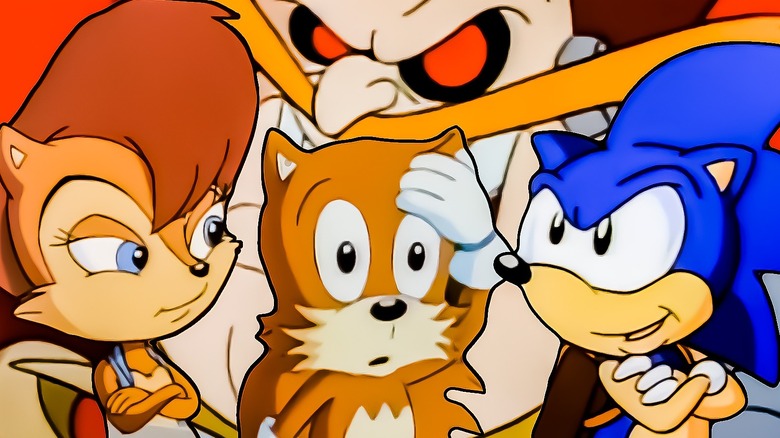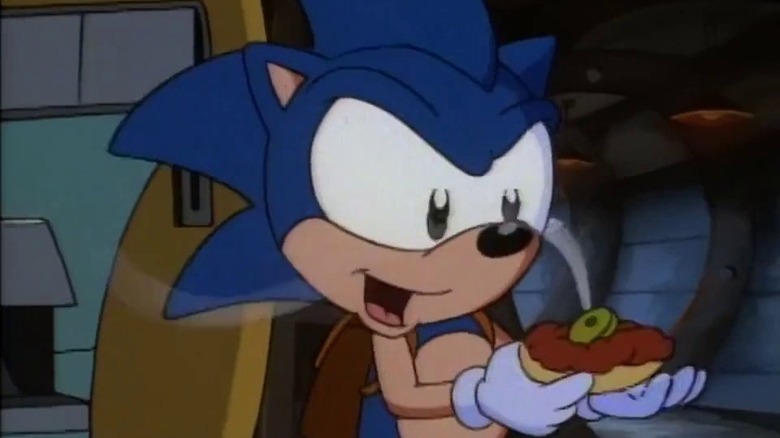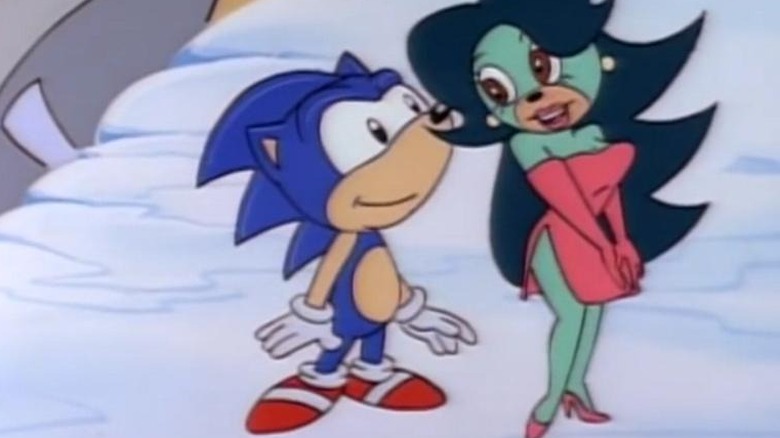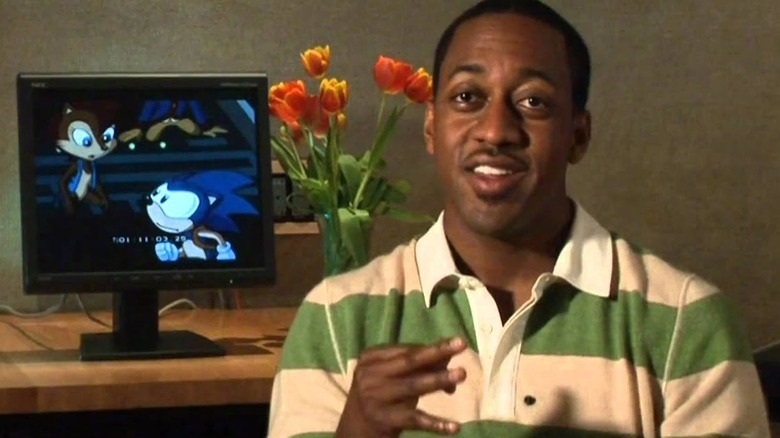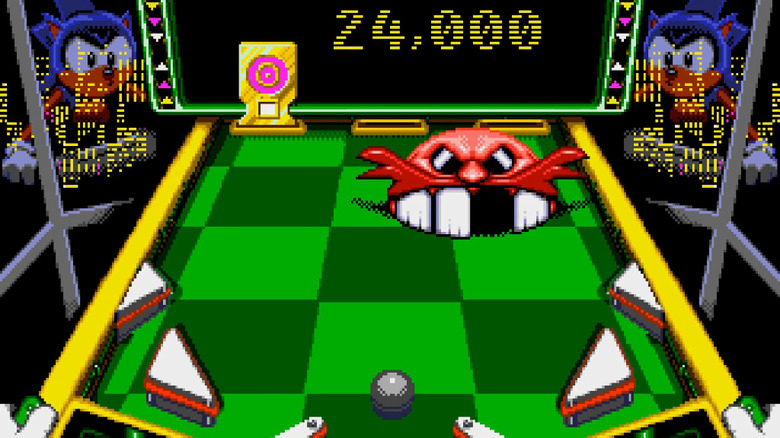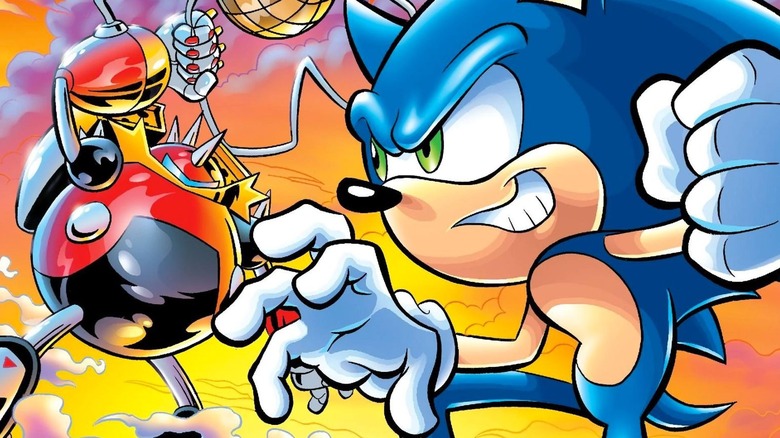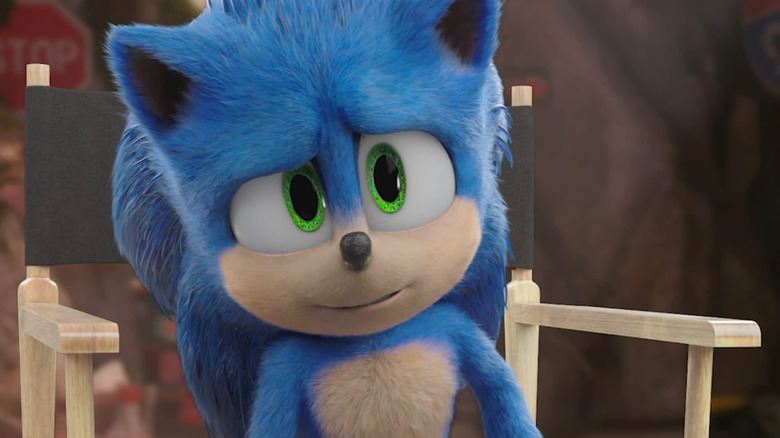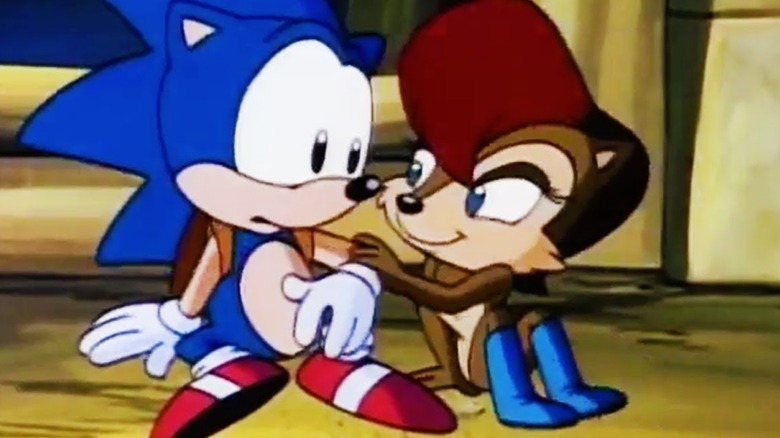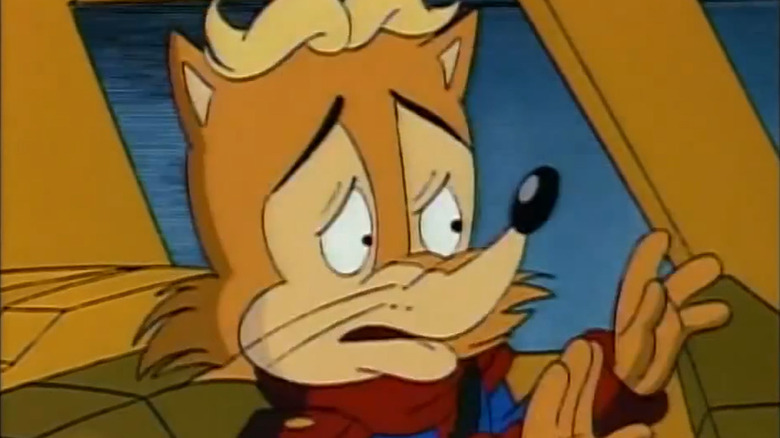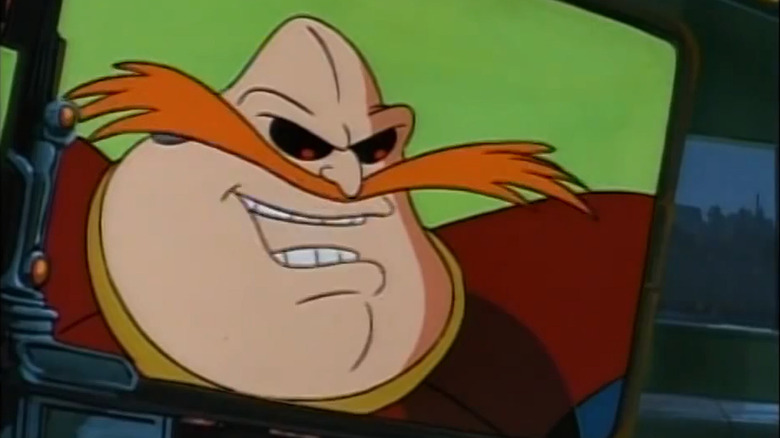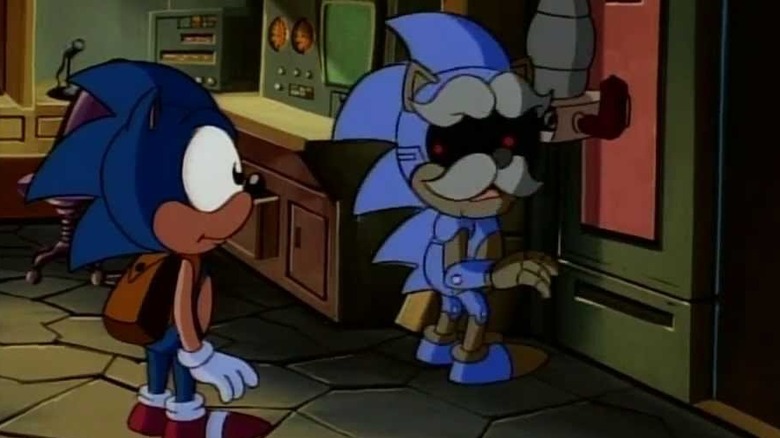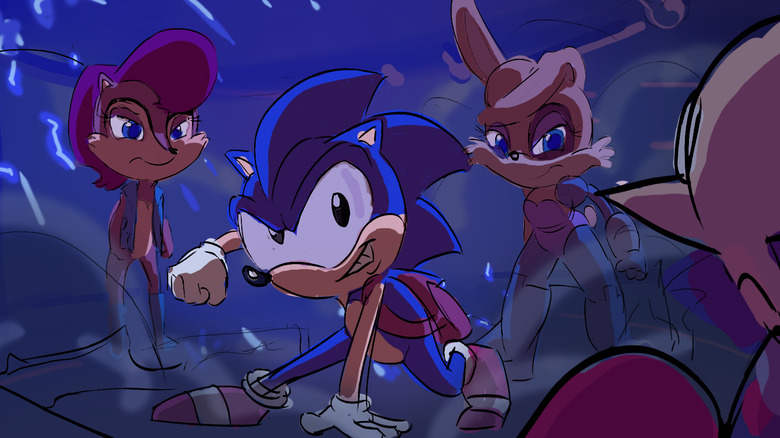Spin Into These Facts About 1993's Sonic The Hedgehog TV Series
Adapting video games to the big and small screen happens so often these days that we take for granted what a novelty it used to be. And one of the first game characters to get their own animated series was Sonic the Hedgehog, an instant phenomenon as both a character and a video game. The first "Sonic the Hedgehog" game almost single-handedly turned the tide in the Nintendo vs. Sega battle of the early-'90s and as kids outgrew their NESes, many found Mario to be too tame and old-fashioned and wanted a character with a little more edge and attitude as they entered their teen years — and they found that with Sonic.
Sonic was such a popular character, in fact, that he actually had two cartoons debut in 1993 that both ran concurrently for a time. We'll dig a little more into that later and talk about the other show – "Adventures of Sonic the Hedgehog" — but this feature will instead focus primarily on the animated series that was simply titled "Sonic the Hedgehog" (later coined "Sonic SatAM" or simply "SatAM" owing to the fact that it ran on Saturday mornings).
For a show that had such a short run, it has maintained a strong fandom and inspired media that ran for many years after the show ended. Here are all of the fascinating tidbits about the making of the show, its impact, and – believe it or not — the future, because it actually might have one.
The show was commissioned by Sega of America
You can't discuss the "Sonic" cartoons without also mentioning the "Mario" programs. Besides the obvious connection between the two franchises by way of their respective video games also being directly pitted against each other in a rivalry that was extremely intense for gamers of the '90s, both shows were also created by DIC Entertainment. The first "Mario" animated counterpart hit a few years before "Sonic" did, by way of 1989's "The Super Mario Bros. Super Show." In the case of "Mario," it was DIC Entertainment CEO, Andy Heyward, who had the idea of a "Mario" cartoon first and brought it to Nintendo.
For "Sonic the Hedgehog," the opposite happened. After several years and multiple iterations of "Mario" shows, it was Tom Kalinske and Michealene Risley of Sega of America who approached DIC about doing a "Sonic" cartoon as well. While it's much more common now for a video game company to help create or at least be involved in adaptations of their properties — see Shigeru Miyamoto's involvement in 2023's "The Super Mario Bros. Movie" – the "Sonic the Hedgehog" cartoon being born from within Sega's own corporate offices was unusual for that era.
It was one of two Sonic cartoons that ran concurrently
We referred to the second "Sonic" cartoon that also launched in 1993 and ran at the same time as "Sonic the Hedgehog." Technically it's the second one, with "The Adventures of Sonic the Hedgehog" debuting earlier in the year. The reason for the two cartoons is complicated and too much to get into here, but to make a long story short, there was some disagreement about how to handle taking what was intended to be a Saturday morning cartoon and expanding it to a weekday one — so the compromise was to just do two different shows entirely.
While "Adventures of Sonic the Hedgehog" is the lighter, funnier, more slapstick-based show, " Sonic SatAM" tended to be a little more serious and have a lot more dramatic elements than the largely humor-based "Adventures" did. While it's not completely unusual to have a property have multiple screen adaptations — as with Mario and the multiple evolutions of his cartoon in the early-'90s — they don't usually run at the same time as the two Sonic shows did. In order to avoid confusion when discussing the shows, the " Sonic SatAM" term was brought to life and it's a shorthand that fans still use to this day.
It features Jaleel White as Sonic for the second of three different shows
For all the ways that "Adventures of Sonic the Hedgehog" and "Sonic SatAM" are different, they have one very interesting connection beyond both having the titular star, deuteragonist Tails, and main villain, Dr. Robotnik. The connection is actor Jaleel White, best known as Steve Urkel from the sitcom, "Family Matters," who voices Sonic in both shows. Even though every other character that the two shows have in common has different actors, White was able to land the role of Sonic in both programs.
White would also reprise the role again in the next "Sonic" animated series, "Sonic Underground," which started (and ended) five years after "Sonic SatAM" ended in 1994. The actor's portrayal of the blue blur is so ubiquitous to a generation of "Sonic" fans that he was asked to play Sonic one last time in a 2013 fan film by Blue Core Studios, which has also done fan films featuring Mega Man and the Ghostbusters. However, White has not returned to the role in any official projects since "Sonic Underground" ended in 1999.
A direct game adaptation fell through, but elements of the show appeared in Sonic Spinball
It was inevitable that video game adaptations would start to then be adapted back into video games. One of the most infamous examples of this is the video game, "Street Fighter: The Movie," which took actors from the 1994 "Street Fighter" film and used them for a game that paled in comparison to the original installments. There were plans to do that with "Sonic SatAM," with in-house Sega developer Sega Technical Institute pitching an idea for a game with the working title, "Sonic-16," to be set in the same universe as the show. However, when the prototype was presented to Sega, management — including the "father of Sonic" Yuji Naka — felt the gameplay was too slow and rejected the pitch.
That wasn't the end of Sega Technical Institute's dalliances with a "Sonic SatAM" game, however. They also developed "Sonic Spinball," a hybrid platform and pinball game in which a rolled-up Sonic served as the ball in pinball-like stages and featured "Sonic SatAM" characters like Princess Sally, Bunnie Rabbott, Muttski, and Rotor. The team had also worked on the ill-fated and never released "Sonic X-treme" for the Sega Saturn, which had initially started life as a game called "Sonic Mars" that would've also featured Sally and Bunnie. Two of the three potential games may have been canceled, but at least some of its characters were immortalized in video game form thanks to "Sonic Spinball."
Early concept art showed that Tails wasn't originally intended to appear
Tails is one of the most famous sidekicks in the history of video games, right up there with the likes of Luigi, Diddy Kong, and the Companion Cube from "Portal." What's easy to forget in retrospect, especially given that he's been by Sonic's side for 30-plus years and across multiple forms of media, is that Tails didn't actually make his debut until the 1992 sequel, "Sonic the Hedgehog 2," and was absent from the original "Sonic" game entirely.
In the early planning stages for "Sonic SatAM," Tails wasn't going to be part of that, either. Concept art from early on in the process of putting the show together reveals a total lack of Tails — though, considering production likely predated the "Sonic 2" North American release, it's likely that he was left out simply because the team didn't know he existed yet. Needless to say, once "Sonic 2" came out and Tails was immediately established as a major character in the universe, he was added to the TV show and made an important part of it.
Also interesting is that the same early character art showed other changes that were made before the final show, including an entirely different team of Freedom Fighters characters with the exception of Sonic and Sally. Some clearly evolved into other characters, while others just got the axe entirely.
The long-running Sonic comics from Archie Comics were initially based on this show
If you're only aware of Sonic as a video game character and star of movies and TV shows, you've missed out on over 30 years of "Sonic" comics and the deep lore within them. In fact, the world of "Sonic" comics has such a devoted fandom that there are some who have abandoned the games entirely — or never even played them — and strictly look at the character, his friends, his allies, and his universe as a comic property first and foremost.
The first "Sonic" comic series came courtesy of Archie Comics and debuted in 1993. Though it obviously drew from the "Sonic" games, the "Sonic" Archie Comics also borrowed heavily from "Sonic SatAM" and focused mostly on that universe until the end of the TV show's run — at which point, it had no choice but to begin taking more of the elements from the subsequent games again.
Still, the comics continued to feature characters and canonical details introduced by "Sonic SatAM" for the comic's entire run, which ran for an impressive 24 years and is the Guinness World Record holder for the longest-running comic book based on a video game. Since 2017, IDW Publishing has been handling the current run of "Sonic" comics.
A movie based on plotlines from the cancelled third season was pitched in 2002
The first "Sonic the Hedgehog" movie got off to a rough start with its first trailer — and that dreadful original design of the character — but the studio overhauled Sonic's look and the 2020 film went on to become the highest-grossing video game movie ever in the U.S. at the time. Only three others have passed it so far, one of which is the movie's own sequel. The original film was the character's big screen debut, but if "Sonic SatAM" writer Ben Hurst had his way, it would've been Sonic's second movie.
Hurst was known in the "Sonic" fan community for remaining passionate about "Sonic SatAM" following its cancellation and spent years sharing details about where he had wanted the series to go and ways he was trying to revive it. Around 2002, Hurst pitched an animated movie that would've followed up on "Sonic SatAM" and covered elements that had been planned for Season 3 before the plug was pulled and it didn't happen.
According to Hurst, things looked promising at first, but Sega's initial interest in the project soon cooled significantly and the company stopped returning his calls on the matter. Hurst remained active in the community and continued to express an interest in trying to revive "Sonic SatAM" in some form until his death in 2010.
All Season 1 episode titles but one contain the word Sonic, while only one episode of Season 2 does
Both the character and video games quickly became so popular that just saying "Sonic" in any context has many people immediately think of a blue hedgehog and or his games before they think of any other connotations of that word. It's such a versatile word and can be applied in numerous ways — which the writers of "Sonic SatAM" had a lot of fun with when coming up with the names for the episode titles of Season 1.
All but one episode title for Season 1 contains "Sonic" or "Sonics," with some of the funnier and more interesting examples being "Hooked on Sonics," "Harmonic Sonic," and "Sonic Boom." The only Season 1 episode that doesn't follow that trend at least uses his buddy's name: Episode 13, "Heads or Tails." As a fun subversion, Season 2 took the exact opposite approach and only had a single episode — Episode 2, "Sonic Conversion" — use "Sonic" while none of the other episode titles did so. It would've been interesting to see what direction Season 3 went in on this matter — maybe half and half?
Tim Curry voiced a recurring character
Besides getting a then-big-name lead actor by way of Jaleel White, most of the "Sonic SatAM" cast was rounded out by voice actors. Still, it was no slouch in that department, bringing on such prolific and well-known voice talent as Rob Paulsen, Jim Cummings, Cree Summer, and Frank Welker. But that's not to say that there weren't any other screen actors on the show — in fact, a particularly noteworthy one also had a recurring role.
Playing Sally's father, King Acorn, across four episodes of "SatAM" was screen and stage legend, Tim Curry. Though he would go on to become an extremely prolific animated voice actor in the decades that followed, he had only just ventured into the world of voice acting on television a few years prior and was still beefing up that part of his resume when he signed on for "Sonic SatAM." Unfortunately, while Curry has also done voice work for over two dozen video games, he has never appeared in any of the "Sonic" games.
It's the only universe where Dr. Robotnik's first name is Julian
Dr. Robotnik aka Eggman has been Sonic's primary nemesis from the very first video game and has remained so for most forms of "Sonic" media. Various details about him can vary wildly from version to version — the ratio of bumbling to menacing, how rotund his body is, his exact origins, whom he has as part of his team, the size of his mustache, how much is or isn't robotic, and so on. But in every version where his first name is stated, that name is Ivo.
Every version, that is, except for "Sonic SatAM." For whatever reason, that show's version of Robotnik has his full name as Dr. Julian Robotnik, which is the only time he's ever been given that name. There is an issue of the "Sonic" Archie Comics that calls back to this by stating that he had previously been known as Julian Kintobor of the House of Ivo, but he was Dr. Ivo Robotnik most commonly and through the majority of the comic's run.
Season 1's episodes were largely self-contained, while Season 2 featured a more overarching storyline
Of the two "Sonic" cartoons that started in 1993, "The Adventures of Sonic the Hedgehog" was more like a sitcom in that it was mostly about jokes, and very little happened in terms of the plot that had any major impact from one episode to the next. On the flip side, "Sonic SatAM" is the one that set out to be deeper, have a more complex story, and allow for things to actually happen to the characters that would change them and their world going forward.
However, this was largely only hinted at during Season 1, where the episodes had more serious plots but were still almost entirely self-contained and could be watched in any order. But Season 2 is where the writers felt emboldened to be a little more ambitious and introduce a bigger, more overarching plot that played out across the entire season and told an ongoing story that necessitated the episodes being watched sequentially. Ben Hurst's Season 3 notes suggest that those episodes were going to directly continue on from Season 2's cliffhanger ending and continue the direction of having the show follow ongoing arcs rather than self-contained episode-by-episode stories.
A fan collective is currently working to create the Season 3 that never was
Even after the passing of Ben Hurst, who had long been the biggest champion of seeing "Sonic SatAM" come back in some form, a group of the show's fans has since taken it upon themselves to actually make the Season 3 that never happened. First announcing themselves in 2019, the group known as Team Sea3on has been posting clips and music to their YouTube channel of what they hope to eventually be an entirely new season of "Sonic SatAM," using Hurst's unused Season 3 notes as well as a beloved fan comic that has been running since 2009 as guides for how to craft the story.
While primarily a fan project, one of "Sonic SatAM's" actual producers is part of Team Sea3on, and the team's animation director has worked on "Star Trek: Lower Decks" and the video game "Skullgirls." And though Sega hasn't officially sanctioned the project yet, they have also yet to speak out against it or shut it down — and there's little chance they haven't caught wind of it by now. Given the company's history of being supportive of fan projects, and even officially hiring people who have worked on fan projects, here's hoping that Sega not only gives Team Sea3on their formal blessing but even fully gets behind it and makes it an official release.
